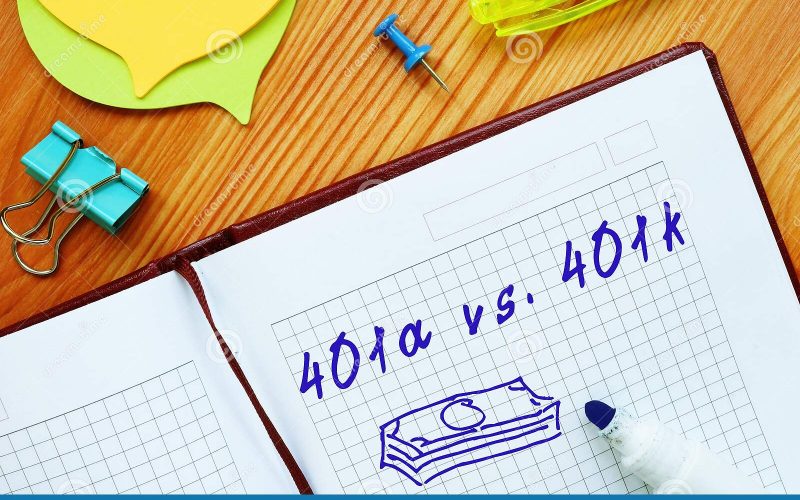As an employee in any company or organization, you must have placed a lot of thoughts into your retirement plan. How life would be for you after you retire or when you leave your job. There are different types of retirement plans available to you depending on the organization you work in. This article will serve as a guide in showing the major difference between the 401(a) vs the 401(k) plan. It will also explain the basic things you need to know about both plans.

Before we rush into the major difference between 401(a) vs 401(k), let us, first of all, know what they mean. Shall we?
What is a 401(a) Plan
A 401(a) plan is a Retirement plan that is available for employees working in a government agency, non-profit organization, and government educational institution. Qualified employees who participate in this plan mostly work as teachers, administrators, and support staff. The 401(a) plan attributes are technically similar to that of 401(k) which are more inherent in profit-based organizations.
The 401(a) usually does not allow an employee to contribute to the 401(k) plans. However, if the employee leaves the organization, he has the right to transfer his funds from the 401(a) to his 401(k) plan.
Employers in 401(a) are eligible to form multiple 401(a) plans. Each of these plans will have distinct eligibility criteria, vesting schedules, and contribution accounts. This serves as an incentive program employers use for employee retention. The employer determines the contribution limits and also controls the plan.
Most times only employees that are 21years of age and have two years of working experience can participate in this plan. These conditions sometimes vary.
What Are the Basic Things You Should Know About a 401(a) Plan?
- 401(a) are only use by governmental or non-profit organizations.
- In a 401(a) plan, both the employee and employer can contribute. It is usually an employer-sponsored plan.
- The employer has a larger scale of control over how the plan is invested in a 401(a) plan.
- An employee can make a withdrawal from a 401(a) plan mostly through a rollover to a different qualified retirement plan.
Now let us discuss briefly the 401(k) plan before going straight to their differences.
What is a 401k) Plan
The 401(k) is somehow similar to that of the 401(a) plan. It is a tax advantage contribution retirement account that employers give to their employers. What this means is that in a traditional 401(a) plan, they do not tax the investments earnings until the employee withdraws the money(after retirement). Employees can make contributions to the 401(k) through automatic payroll withholding. They can also match some or all of these contributions. However, in the Roth 401(k) plan withdrawals can be tax-free.
Basically, there are two types of 401(k) accounts. They are the traditional 401(k)s and the Roth 401(k)s. They also refer to it as “designate Roth account.” Both are similar in some ways but the taxes are in different ways. An employee can have either type of account or both types.
A 401(k) plan can be referred to as the define-contribution plan. Both employer and employee can contribute to the account, up to the dollar limits set by the Internal Revenue Service (IRS).
In contrast, traditional pensions are not to be confused with traditional 401(k)s are referred to as defined-benefit plans. In this case, the employer is responsible for providing a specific amount of money to the employee upon retirement.
These recent times, the 401(k) plans have become more practice, thereby making traditional pensions increasingly rare, as the responsibility and risk for retirement is no longer in the hands of the employers but that of their employees.
What Are the Basic Things You Should Know About a 401(K) Plan?
- There are basically two types of 401(k)s plan—traditional and Roth—which differ primarily in taxation process.
- In a Roth, employees make contributions with post-tax income but can make withdrawals tax-free. But In a traditional 401(k), employee contributions reduce their income taxes for the year they are made, but their withdrawals are taxed.
- A 401(k) plan is a company-sponsored retirement account that employees can contribute to.
Having known what is 401(a) and 401(k) plans, let us now discuss their fifteen major differences. Shall we?
401(a) vs 401(k) 13+ Major Difference Between
- The 401(a) plans are offered by government and nonprofit employers, while the 401(k) plans are common in the private sector or corporate employers.
- Participation in a 401(a) plan is mandatory, while with a 401(a) plan, it is mostly mandatory.
- In 401(k) plans, participants decide how much they wish to contribute to their plan. While in 401(a) employee contributions are determined by the employer.
- The 401(a) plan is only offered to specific employees as an incentive for them to continue their work within the organization. On the other hand, the 401(k) plan is available to every full-time employee within a company.
- With a 401(a) employers sets the limit for the contribution. While for the 401(k) plan, an employee can decide how much money he or she would like to contribute to the retirement savings account.

Read Also: 401(a): Understanding What a 401(a) plan is with Ease
- with a 401(k), the company match policy is what will determine if an employee will contribute. For the 401(a) plan, the employer must make financial contributions to the plan. However, employee contribution isn’t always mandatory. It can also be voluntary.
- Section 410(a)(1) of the Internal Revenue Code(IRC) mandates that an individual must be at least 21 years old or have completed a certain tenure at the company to be eligible for a 401(a) or a 401(k). For 401(a) the length of time is two years while for 401(k) plans the length of time is one year.
- As of 2020, employees can contribute up to $57000 for the 401(a). While for the 401(k), an employee can only contribute up to $19500.
Read Also: 401 (k) WITHDRAWALS: Rules and 4 ways to avoid penalties
- Most 401(k) plans offer various investment options ranging from low-risk investments like manipular bonds and annuities to equity funds that invest in stocks and reap higher returns. While 401(a) plans may seek investment advice through the plan’s advisor or allow employees to simplify diversified portfolios.
- Employees lose out on a tax break if they borrow from their 401(k) because they are repaying it with after-tax dollars. But that doesn’t apply when borrowing from the 401(a).
- Employees in the 401(a) can withdraw money from their account without penalty when they turn 59½. If they make any withdrawals before 59½, they will need to pay a 10% early withdrawal penalty. While for the 401(k) With a 401(k), if an employee retires at age 55, they can start withdrawing money without penalty.
- zIn a 401(a) profit-sharing plan, the employer’s contributions are discretionary, and they may not contribute to the plan every year. Unlike the 401(a) plan that is a tax-advantaged account used to save for retirement. Employers and employees contribute to the account based on a set formula determined by the employer.401(a) plans.
Conclusion
In conclusion, the largest difference between 401(a) and 401(k) plans is the type of employers offering the plans. Whereas 401(a) plans typically are offered by government workers and employees from specific education institutions and nonprofits, 401(k) plans are offered by for-profit organizations.
401 (a) vs 401 (k) FAQ
Whats the difference between a 401k and 401a?
the largest difference between 401(a) and 401(k) plans is the type of employers offering the plans. Whereas 401(a) plans typically are offered by government workers and employees from specific education institutions and nonprofits, 401(k) plans are offered by for-profit organizations.
What is a 401a plan?
A 401(a) plan is a Retirement plan that is available for employees working in a government agency, non-profit organization, and government educational institution.






